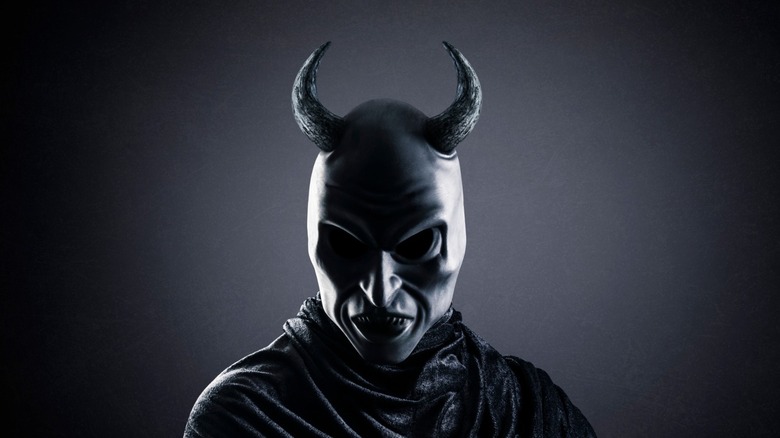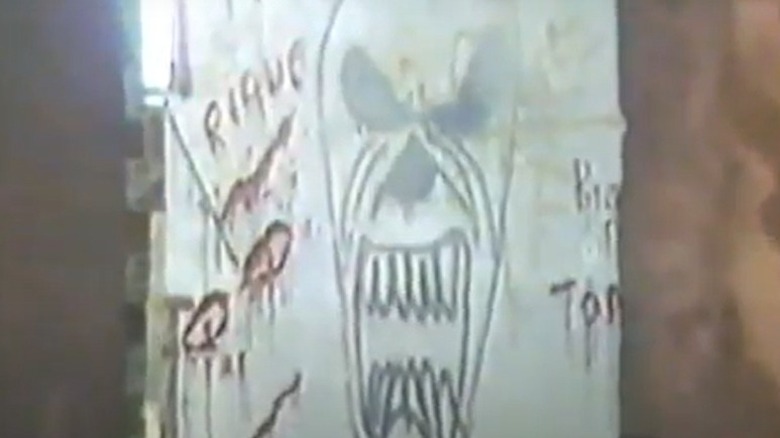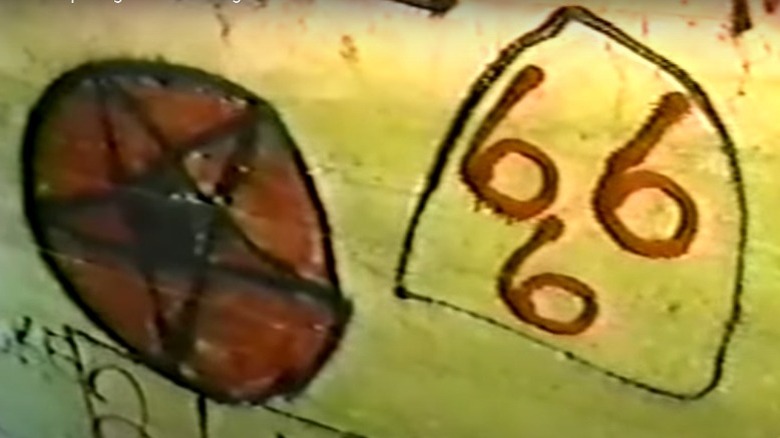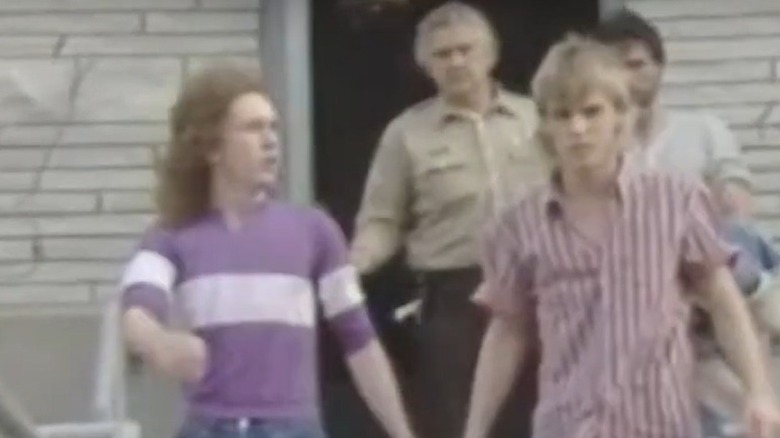The 1987 Murder Of A Teen Who Was Allegedly Offered Up As A Sacrifice To Satan
The Satanic panic that gripped the United States during the 1980s and '90s was sensationalized by every tier of media. From the tabloids to respectable journalism, the press published story after story detailing an alleged pandemic of Satanic cult activity invading every corner of the nation. Daytime talk show host Geraldo Rivera ran a two-hour NBC special in 1988 called "Devil Worship: Exposing Satan's Underground." The program left many viewers with the feeling that their children were being targeted and influenced by the Satanic overtones of heavy metal music, with Rivera himself saying "there is no doubt that teenage Satanic activity in this country is increasing dramatically." After 120 minutes of devilish imagery, raucous teenage concertgoers, and interviews with both murderers who blame their crimes on their love of the devil and the "experts" on Satanic cult activity, it's no wonder that so many parents were becoming paranoid.
Bookracks at local supermarkets were filled with accounts on the subject of Satanic ritual abuse. Beginning with the 1980 book "Michelle Remembers" (a later debunked account of Satanic ritual abuse), the moral outrage and fear spread like a fevered plague, with many parents and local law enforcement agencies convinced that a network of Satanic cults existed and was targeting their children (per Vox). Even though extensive FBI investigations revealed that there was little to no evidence of any organized Satanic conspiracies, the fire was a tough one to extinguish. No conspiracy may have existed, but there were still several unlinked cases of self-styled Satanists committing murder.
What began as a morbid hobby of killing small animals soon turned into murder
The 1987 murder of Carl Junction teen Steven Newberry shook the rural Missouri community to its core (via the Los Angeles Times). On December 6, Newberry was paid a visit by his good friend Jim Hardy, a classmate from school (per Justia). Joining Hardy were two other young men, Pete Roland and Ron Clements. When the four of them left Newberry's house early that evening and drove to a secluded spot near the railroad tracks, Newberry believed that they were only going to kill a kitten that Hardy had brought along. What the teen didn't realize was that Hardy, Roland, and Clements had a larger target in mind.
It wasn't the first time that anyone from this group had killed a small animal. The Los Angeles Times reports that the previous summer, Roland and Hardy had killed more animals than they could have counted, sometimes killing as many as four in a day. In one particularly horrific act, they placed an animal in an abandoned dryer, doused it with paint thinner, and set it ablaze. Laughing about the suffering they were causing the poor creature, hindsight might show that the leap these youths made from small animals to human beings wasn't a big one.
The four of them took turns beating the kitten to death. As Newberry stood by catching his breath, he heard Hardy give the command to the others — "Do it now!" — and felt Hardy's bat smash into his face.
Newberry was beaten to death by three teens he thought were his friends
Jim Hardy, Pete Roland, and Ron Clements brutally attacked their friend, each armed with the baseball bats that they had used moments before to kill the kitten. Newberry had been felled by the first blow but managed to get up and run away. But his effort to flee was in vain. Pursued by his friends, they quickly caught up to him, striking him over and over again until he lay motionless. It was estimated that each of the three had struck Newberry 20 times with a bat (via Justia).
Newberry's body was bound with rope, a heavy rock tied to his waist. He was hoisted into an abandoned cistern that still contained water. After disposing of his body, Hardy, Roland, and Clements disposed of their murder weapons in different places, then drove off into the Sunday night. They traveled to Hardy's home, where the three of them agreed to tell anyone who asked that the last time they saw Newberry was when they dropped him off at a nearby convenience store.
When he didn't return home, Newberry's mother phoned the police. An investigation was launched, and all three of Newberry's friends were questioned by police at school the following day. Seeing holes in their stories, they brought them into the police station for additional questioning. It didn't take long to get a confession and for police to be led to the cistern, where they found Newberry's lifeless body.
What could have been categorized as another tragic homicide would soon be linked to a devilish motive.
Satan was a dominant theme throughout
As if the act of murder itself weren't enough, the investigation revealed many morbid details about the lives of the teenage killers. Jim Hardy and his cohorts were avowed Satanists, the Los Angeles Times reports. They had begun poring over books about witchcraft and the occult, memorized and chanted demonic incantations, and were all known to have professed their allegiance to the devil. Hardy and Ron Clements began their obsession with the dark arts early in high school, their thirst for it growing as they progressed grade by grade. Schoolmates and teachers would recall how their appearances changed, each wearing an inverted cross earring, and Hardy beginning to show up in class with ratted T-shirts featuring his favorite metal bands.
Their journal entries were full of Satanic imagery and lurid descriptions of sexual fantasies and horrific violence. Hardy had been torturing and killing stray cats and dogs since he was a pre-teen but was doing so at an increasing rate. The high schoolers began to openly discuss these acts with their peers, even talking about what it would be like to murder a person. Most of the kids just laughed it off, believing that Hardy and the others were joking. And though Hardy would later argue that none of the animals he killed were meant as an offering to Satan, he did proclaim that he was a disciple of the devil. According to the Los Angeles Times, when their senior year started, he told some of his friends that the "ultimate goal" was human sacrifice.
The root cause was likely mental health issues that were ignored
Amid the Satanic Panic that was taking hold during the late 1980s, it was a case as curious as it was horrific. Three teen boys from a small midwestern town are arrested for offering up a classmate as a sacrifice to Satan. The heavy metal music they listened to, the clothing and jewelry emblazoned with Satanic imagery, and the seemingly endless and open discussions of death and their obsession with the occult certainly seemed like the harbingers of doom that the evangelicals and community activists were coming true.
The reality could be looked at as a more depressing chain of events. Each of the three teens was revealed to have had serious drug problems (via the Los Angeles Times). Compounding that issue was the state of their mental health, particularly with Jim Hardy and Ron Clements. Hardy had been troubled since he was young, popping pills and killing animals long before he had ever heard a Slayer tune. Clements' mother had tried to get her son psychological help, as he would confess to a therapist his disturbing murder fantasies. Roland would later say he heard voices commanding him to kill and that he believed that Satan was giving him powers. Per the Los Angeles Times, before Steven Newberry's murder, Hardy would tell some friends that he believed Satan had a grip on him and was urging the teen to "prove himself."
If you or anyone you know is struggling with addiction issues, help is available. Visit the Substance Abuse and Mental Health Services Administration website or contact SAMHSA's National Helpline at 1-800-662-HELP (4357).
If you or someone you know needs help with mental health, please contact the Crisis Text Line by texting HOME to 741741, call the National Alliance on Mental Illness helpline at 1-800-950-NAMI (6264), or visit the National Institute of Mental Health website.
All three are free men today
Jim Hardy, Ron Clements, and Pete Roland were all charged with first-degree murder. Hardy avoided trial and the possibility of a death sentence in exchange for a plea of guilty. Clements and Roland entered pleas of not guilty but were both convicted by juries.
All three teens were sentenced to life without parole, seemingly doomed to spend the rest of their lives behind bars. But a 2012 U.S. Supreme Court ruling paved the way for their potential release (via The Joplin Globe). The nation's highest court handed down a decision that deemed "life without parole" a form of cruel and unusual punishment, a violation of the Eighth Amendment, if the offender was a minor at the time of the crime. As all three were under 18 when the murder of Steven Newberry was committed, this would make each of the convicted murderers eligible to apply for parole.
In March 2021, it was announced that Clements would be allowed to go free after spending more than 30 years in prison. Roland and Hardy were paroled in August 2021 and August 2022, respectively (per The Joplin Globe). Newberry's mother, Marlys Horn, expressed some concern about the release of the men who beat her son to death. But ultimately, she showed piety about the trio going free and made a plea for them not to be harassed and for the community to give them another chance. "I really think that is the best thing to do; the community has to accept that," she told the media outlet. "If I can show I can accept it, there is no reason for anybody else not to. If I can live with it, certainly they can too."





